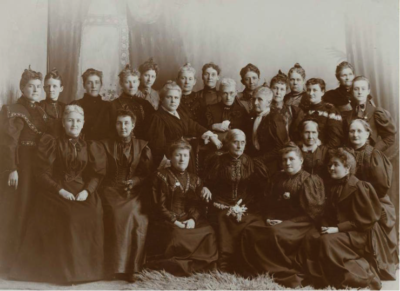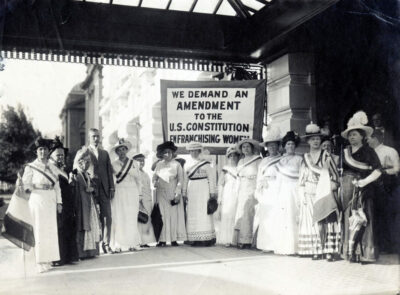Editor's Note
Today’s guest post is by Barbara Jones Brown, executive director of the Mormon History Association. She previously served as historical director of Better Days 2020, a nonprofit dedicated to increasing awareness of Utah’s role in the suffrage movement and women’s activism. Her co-authored book on the aftermath of the 1857 Mountain Meadows Massacre is forthcoming from Oxford University Press. To join us tonight at 7pm EST for our FREE #USIH2020 plenary on “The Suffrage Movement in America’s Intellectual Tradition,” please register here.

Western suffragists, including Utahns Martha Hughes Cannon, Sarah M. Kimball, Emmeline B. Wells, and Zina D. H. Young, pose with national suffrage leaders Susan B. Anthony and Anna Howard Shaw at the 1895 Rocky Mountain Suffrage Meeting in Salt Lake City (Utah State Historical Society).
The year 2020 marks not only the centennial of the 19th Amendment, but also the sesquicentennial of voting rights for Utah women. The Utah Territorial Legislature granted voting rights to women in February 1870. On February 14 of that year, Utah women became the first in the nation to cast votes under an equal suffrage law. From that time forward, Mormon women became staunch supporters of women’s voting rights, working through the decades with national leaders like Susan B. Anthony, Carrie Chapman Catt, and Alice Paul to help secure national voting rights for women through an amendment to the U.S. Constitution.
When the territory of Utah became a state in 1896, its Constitution expanded rights for women by granting them the right to run for public office. That year, Dr. Martha Hughes Cannon was elected state senator, marking another first for Utah, as she became the first woman in the United States to serve as a state senator—nearly 25 years before most women in the country could even cast a vote. Last year, Utah’s legislature voted to create and place a statue of Cannon, representing Utah, in the National Statuary Hall in the U.S. Capitol.

Members of the executive committee of the national suffragists’ convention and prominent local suffragists snapped this photo with Senator Reed Smoot in August 1915 outside of the Hotel Utah, after meeting with him to ensure his support for a federal women’s suffrage amendment in the next Congress. From L to R: Marie Mahon of New York, Hannah S. Lapish, Emmeline B. Wells, Senator Reed Smoot, Lily C. Wolstenhome, Elizabeth Hayward, Margaret Zane Cherdron, Lucy A. Clark, Mrs. J. H. Saxson, Mrs. A. D. Paine, Lillie T. Freeze, Ruth M. Fox, Mrs. Charles Livingston, Mrs. L. R. Tanner, and Mrs. M. B. Lawrence (National Woman’s Party).
Scholarly sources on the Latter-day Saints’ role in the women’s suffrage movement and early activism include Laurel Thatcher Ulrich’s A House Full of Females: Plural Marriage and Women’s Rights in Early Mormonism, 1835-1870 (Vintage Books, 2018), Jill Mulvay Derr et al, eds., The First Fifty Years of Relief Society: Key Documents in Latter-Day Saint Women’s History (Church Historian’s Press, 2016), Carol Cornwall Madsen’s biography of Utah’s leading suffragist, Emmeline B. Wells: An Intimate History (University of Utah Press, 2017), and Madsen’s anthology of Mormon suffragists’ writings, Battle for the Ballot: Essays on Woman Suffrage in Utah, 1870-1896 (Utah State University Press, 1997).
Each of these scholars of Mormon women’s history, along with panelists Katherine Kitterman and Benjamin Park, are members of the Mormon History Association (MHA). First founded in 1965 as an affiliate of the Western History Association, since 1972 MHA has been an independent organization dedicated to the study and understanding of all aspects of the Mormon past. MHA strives to be the preeminent catalyst and forum worldwide for encouraging the scholarly pursuit of Mormon studies and history. The association pursues this mission by sponsoring annual conferences, publishing the Journal of Mormon History, encouraging the highest quality of research and publication, and awarding book, article, and student prizes in the field. Membership in the association is open to all, irrespective of religious affiliation, academic training, or world location. To learn more about MHA and the Journal of Mormon History, visit www.mormonhistoryassociation.org.

0